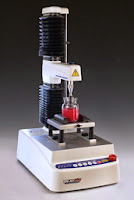 So – what is texture analysis?
So – what is texture analysis? It goes without saying that when it comes to food, taste is one of the foremost important factors influencing consumer acceptance. So it makes sense that manufacturers have, for a very long time now, been working to craft and hone the ideal taste for their products.
Manufacturers have also been quick to recognise the importance of other factors, such as health, price and appearance. Some, however, have been far slower to realise the crucial impact of texture. Texture is a food product’s defining factor – getting it wrong can mean rejection by consumers. A product could taste great, have a healthy advantage, and look fantastic, but if the texture doesn’t hit the mark, it just won’t work.
For those who are new to this field of science the following articles give a good introduction in several explanatory styles:
• Food Texture: how important is it? – a fabulous summary written in The Guardian
• Food Texture: IFST Learning Zone ideas for Food Science & Technology Teachers
• How Science Measures Food
• Texture and Mouthfeel: from rheology to tribology and beyond
• Importance of Texture Measurement – Food Product Design.com
Texture: Top of the Agenda
It’s taken time, but the food industry now seems to be really getting to grips with texture’s true potential. This is obvious when you look at the direction in which many food companies are currently moving. With the emphasis strongly on mouthfeel, texturisers of all shapes and sizes are being launched into an already competitive market. And it’s not just about perfecting a specific texture – it’s about creating new ones too.
 Texture analysis instrumentation has been helping manufacturers to measure and perfect texture for decades, and its scope is continually widening. Texture now tops the agenda; sensory panels are being accompanied by sophisticated instruments that quantify attributes such as stickiness, crunchiness and chewiness.
Texture analysis instrumentation has been helping manufacturers to measure and perfect texture for decades, and its scope is continually widening. Texture now tops the agenda; sensory panels are being accompanied by sophisticated instruments that quantify attributes such as stickiness, crunchiness and chewiness. As the food industry moves forward, texture analysis seems always ready to move with it, offering creative solutions for every need. And with recent advancements including simultaneous force, distance, acoustic and video recordings, we’re sure to see manufacturers and suppliers achieve more great things with texture analysis in the future.
 |
 |
 |